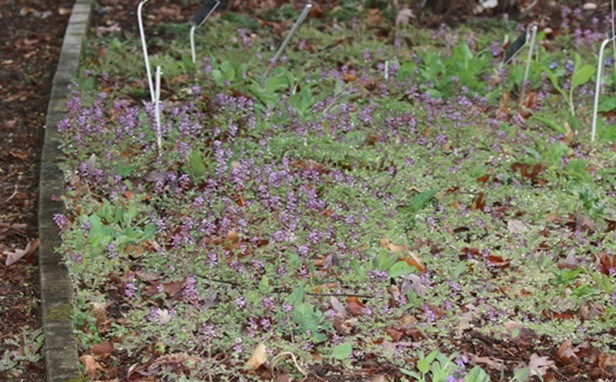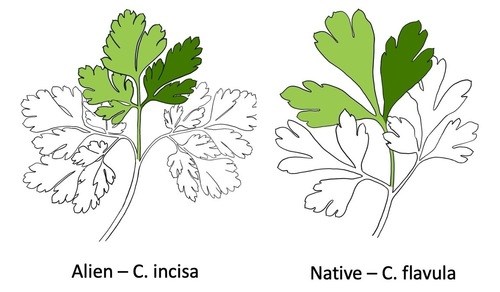Last updated: May 6, 2024
Article
Incised Fumewort (Corydalis incisa)

KENPEI (CC BY-SA 3.0), Wikimedia
Incised fumewort (Corydalis incisa) is an annual or biennial herbaceous plant native to East Asia. It was first detected in Bronx County, NY in 2005 (New York Botanical Garden, 2016). Since its first observation, C. incisa has spread rapidly across Pennsylvania, District of Columbia, Virginia, Maryland, and North Carolina. Observations from iNaturalist show populations as far west as Illinois and Tennessee. In 2017, only one observation was made on iNaturalist within the National Capital Region and 10 across the entire US. As of February 2024, there are 642 observations, compared to a nationwide count of 1,456.
In 2017, the USDA concluded that this is a “high risk” invader, which means that it has both the potential to become widespread and the potential to cause a lot of damage:
“As demonstrated by its status in the United States, C. incisa exhibits a strong ability to escape and spread. It is a shade-tolerant (Fleming, 2017; Glick, 2017) annual/biennial (Zhang et al., 2008) that is self-compatible (Zhang et al., 2009) and has a high reproductive capacity (Nakanishi, 1994). Plants ballistically eject seeds out of the capsules up to three meters away (Nakanishi, 1994). Seeds can then be further dispersed by either ants (Andruk, 2017; Zhang et al., 2008) or water (Atha et al., 2016a). US evidence indicates that plants are likely being dispersed as contaminants in nursery material (Maurer, 2017). Plants can form dense patches and seem tolerant to hand-pulling and clipping at certain stages of their life cycle (Atha et al., 2016a; Atha et al., 2014b; Andruk, Hudson, and Nolan, unpublished data - provided by Andruk, 2017).”

Ron Wertz, iNaturalist (CC BY-NC_SA 4.0)
Identification
Corydalis incisa grows up to 2 feet tall. Based on our field experience in the National Capital Region, the life cycle begins in spring when seeds germinate and grow into small rosettes supported by a tiny tuber. The leaves are compound and divided into 3 leaflets, and again into another 3 sub-leaflets that are lobed to serrated. The leaves go dormant for the summer and re-emerge directly from the tuber in the fall. They are evergreen throughout winter. Stems emerge in February and blooming occurs from March through early May. There are about 10 to 16 flowers per raceme. The fruits, which are oblong, pod-shaped capsules, form quickly. The first seeds disperse about three weeks after the first flowers. By early summer, the mature plants are dead. Corydalis incisa can be found in waterways, rock walls, disturbed areas, and “mesic and alluvial habitats” (Maryland Department of Agriculture, 2017).

Left to right, top to bottom: KENPEI (CC BY-SA 3.0), Wikimedia; novakbynature (CC BY-NC-4.0), jas_d (CC BY-NC4.0), iNaturalist; and Sara Tangren, National Capital PRISM (CC BY).
Native Look-A-Like
Be careful not to confuse the invasive C. incisa with the native yellow corydalis (Corydalis flavula). The leaves of C. flavula are blue-green-gray to green. The sub-leaflets on C. flavula are heavily lobed but not as divided as C. incisa. The easiest way to differentiate the invasive from the native are when they are flowering. The invasive species has purple flowers while the native (C. flavula) have yellow flowers. Corydalis flavula can be found along riverbanks, rock outcrops, and slopes.

Left to right: Terri Koontz (CC BY-NC 4.0); Richard Joyce (CC BY-NC-4.0), iNaturalist; and Sara Tangren, National Capital PRISM (CC BY).
There are also some qualitative differences between the two types of leaves, but unless you have them side by side, it’s hard to use qualitative differences for identification. For example, in winter, the alien leaves tend to be darker, but sometimes lighter toward the center, and they tend to have little white spots on them (glands perhaps?). These differences are useful but gradational, somewhat inconsistent from plant to plant, and fade as winter moves into spring.

Left: izafaar, (CC BY-NC). Right: sara_tangren, (CC BY-NC-SA), iNaturalist.

Sara Tangren, National Capital PRISM (CC BY).
If you see C. incisa, we highly encourage you to report it! iNaturalist is an app and website that lets you upload photos of and identify organisms you see outdoors. We use iNaturalist to monitor the spread of C. incisa and many other invasive species throughout the National Capital Region.
Tips for making a good observation record of Corydalis:
Take photographs that show:
- the landscape around the plant – this shows the context and offers a clue to the scale of the infestation
- if they are flowering, show a whole plant including flowers and leaves
- if they aren’t flowering yet, show a whole, typical, undamaged leaf
Make comments that:
-
are explicit about the issue of intentional plant vs. weed vs. escaped (this saves reviewers a few minutes checking for cues of cultivation in the photo and zooming in on the map)
-
give a rough estimate of the number of patches and/or the area covered
-
any other comments you think might be helpful
References
New York Botanical Garden. n.d.. Early Detection, Rapid Response: Applying the Resources of the New York Botanical Garden to an Emerging Invasive Species. Emerging Invasive: Corydalis incisa.
Maryland Department of Agriculture. 2017. Corydalis incisa WRA.
Ossi, D. 2017. An incisive invader- Corydalis incisa. An Incisive Invader: Incised fumewort.
Swanson, S. 2016. Incised fumewort invasive Project. New York Botanical Garden Library Guide.
United States Department of Agriculture. 2017. Weed Risk Assessment for Corydalis incisa (Thunb.) Pers. (Papaveraceae) – Incised fumewort.
Tags
- antietam national battlefield
- catoctin mountain park
- chesapeake & ohio canal national historical park
- george washington memorial parkway
- greenbelt park
- harpers ferry national historical park
- kenilworth park & aquatic gardens
- manassas national battlefield park
- monocacy national battlefield
- national capital parks-east
- prince william forest park
- rock creek park
- wolf trap national park for the performing arts
- ncr
- invasive
- invasive plants
- early detection
- ipmt
- corydalis incisa
- incised fumewort
- plants
- nature
- corydalis flavula
- invasive species
